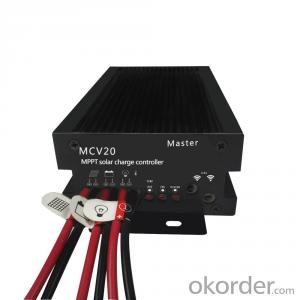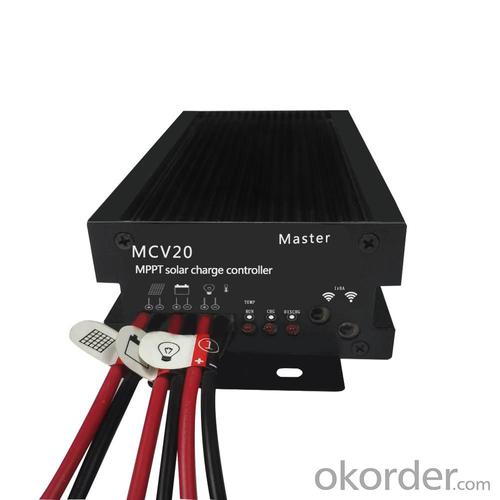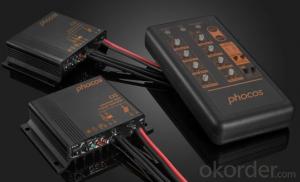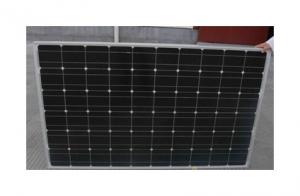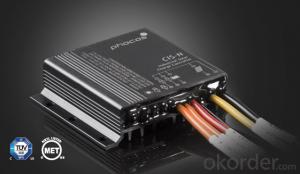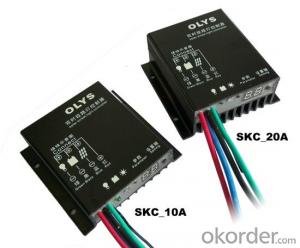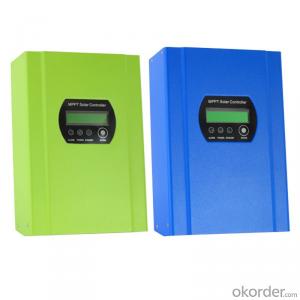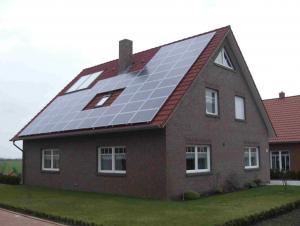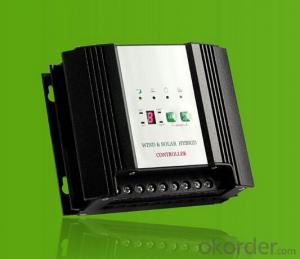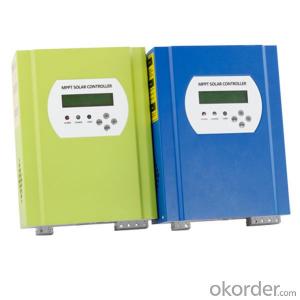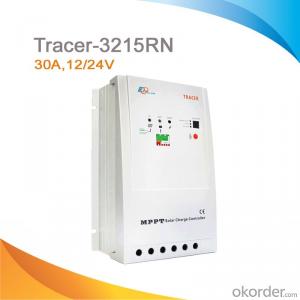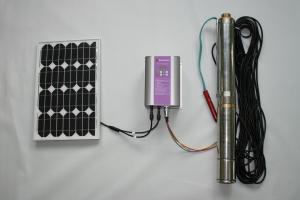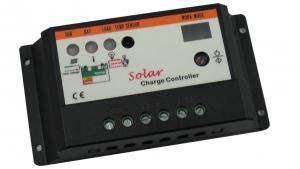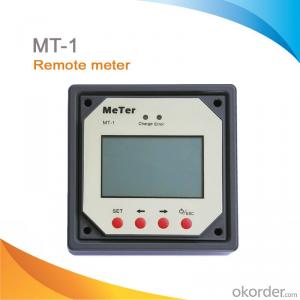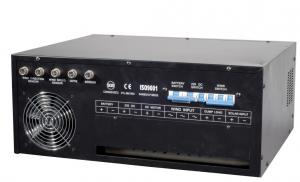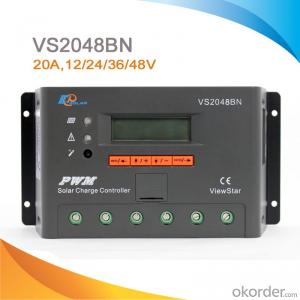30 Amp Rv Solar Panel Controllers - Intelligent 12V 24V Inverter Charger MPPT Solar Battery Charger Controller with Temperature Sensor
- Loading Port:
- China main port
- Payment Terms:
- TT OR LC
- Min Order Qty:
- 1 pc
- Supply Capability:
- 10000 pc/month
OKorder Service Pledge
OKorder Financial Service
You Might Also Like
1.Features :
1). Professional design to promote system reliability
2).High MPPT tracking efficiency up to ≥99.9% and high system efficiency up to 98%, Maximizes solar panel power output & reduces system costs.
3). Using industrial DSP digital technology, without any adjustable resistance, strong anti-interference ability, no aging and drift.
4).High LED driving and charging efficiency, significantly reduce the product temperature.
5).Three phase time charge battery, which contains MPPT charge, constant voltage charge and float charge.
6)Significantly extends the battery lifetime up to 50% base on intelligent temperature compensation charge and discharge management.
7)Intelligent energy management of battery ensures that the battery charge & discharge in shallow state which significantly extend the battery life.
8). User programmable for battery types, load control etc.
9).Infrared wireless communications, connecting with a handheld remote control for easy installation.
10). IP68 Waterproof without any button.
2. Technical parameters
| Item | Content | Model MCV20 | Unit |
| Battery Parameters | System voltage | 12/24V Auto recognition | - |
| Max. charge current | 20 | A | |
| Charge voltage range | 8~30 | V | |
| MPPT charge@25°C | ≤14.4(12V),≤28.8(24V),≤57.6(48V) | V | |
| Boost charge @25°C | 14.4(12V),28.8(24V),57.6(48V) | V | |
| Float charge @25°C | 13.8(12V),27.6(24V),55.2(48V) | V | |
| Deep discharge protection, Cut-off voltage@25°C | 10.8(12V),21.6(24V),44(48V) | V | |
| Reconnect voltage@25°C | 11.8(12V),23.6(24V),48(48V) | V | |
| Battery Temperature compensation | -4mV/°C/2V | - | |
| Solar panel parameters | Max panel voltage | 100 | V |
| Start voltage | ≤85 | V | |
| Max.panel power | 260(12V), 520(24V) | W | |
| MPPT track range | 15≤Vp≤75(12V), 30≤Vp≤75(24V) | V | |
| Output parameters | Output current | 20 | A |
| Overload, short circuit protection | 105%~150% Times the rated current 10 minutes 150%~200% Times the rated current 1 minutes ≥200% Times the rated current 20 millisecond | - | |
| Light control function | Yes | - | |
| Time control function | Yes | - | |
| System parameters | System grounding design | Co design | - |
| MPPT efficiency | ≥99.9% | - | |
| Max.charge efficiency | 98.50% | - | |
| Consumption in sleep mode | ≤0.5W | mA | |
| Communication | Infrared | - | |
| History Data | 1 | Year | |
| Operating temp. | -25~60 | °C | |
| Operating Humidity | 0~100% | RH |
3. Image

4. FAQ
Q:DO YOU HAVE ANY CERTIFICATION FOR YOUR PRODUCTS?
A:We have ISO9001:2015,CE、RoHS certifications for all of our products.
Q:DO YOU HAVE MOQ FOR PLACE ORDER?
A:Low MOQ,1pe for sample checking is availabl
- Q: How does a solar controller handle battery temperature compensation?
- A solar controller handles battery temperature compensation by monitoring the temperature of the battery and adjusting the charging parameters accordingly. The controller uses sensors to measure the temperature and then adjusts the charging voltage and current levels to ensure optimal charging and prevent overcharging or undercharging of the battery. This helps to extend the battery's life and improve its overall performance.
- Q: Can a solar controller be used with solar panels that are connected to a charge controller?
- Yes, a solar controller can be used with solar panels that are connected to a charge controller. The solar controller monitors and regulates the charging process of the batteries connected to the charge controller, ensuring optimal performance and preventing overcharging or discharging. It enhances the efficiency and longevity of the solar panel system by managing the flow of energy from the solar panels to the batteries.
- Q: Can a solar controller handle different battery types (lead-acid, lithium-ion, etc.)?
- Yes, a solar controller can handle different battery types such as lead-acid, lithium-ion, and others. However, it is important to choose a solar controller that is specifically designed to support the specific battery technology being used. Different battery types have varying voltage and charging requirements, so using a compatible solar controller ensures efficient and safe charging for the specific battery type in use.
- Q: How does a solar controller monitor the battery voltage?
- A solar controller monitors the battery voltage by continuously measuring the voltage level of the battery. It uses built-in sensors and circuitry to accurately measure the voltage and then adjusts the charging and discharging processes accordingly to maintain the battery within safe voltage limits.
- Q: Can a solar controller be used with different types of charge controllers?
- No, a solar controller cannot be used with different types of charge controllers. Each type of charge controller is designed to work with specific types of solar panels and batteries, and using a different type of charge controller may result in compatibility issues and potential damage to the system. It is important to use the correct charge controller that is compatible with the specific solar panels and batteries being used.
- Q: Can a solar controller be used with solar panels that are mounted on a boat?
- Certainly, solar panels mounted on a boat can indeed be utilized alongside a solar controller. In fact, it is strongly advised to employ a solar controller in such circumstances to effectively manage the charging procedure and safeguard the battery bank on the boat. By monitoring the voltage and current originating from the solar panels, a solar controller assists in averting overcharging, which could potentially harm the batteries. Additionally, it optimizes the charging process by ensuring that the batteries receive an appropriate charge based on their current state. Consequently, incorporating a solar controller with solar panels on a boat is not solely feasible but also highly advantageous for enhancing the overall performance and lifespan of the battery system.
- Q: How do I integrate a solar controller with an existing solar panel system?
- To integrate a solar controller with an existing solar panel system, you will need to follow a few steps: 1. Determine the compatibility: Firstly, ensure that the solar controller you have is compatible with your existing solar panel system. Check the specifications and requirements of both the solar controller and the solar panels to ensure they can work together. 2. Disconnect the existing connections: Before connecting the solar controller, you need to disconnect the existing connections from the solar panels. This involves turning off the solar panel system and disconnecting any wires or cables attached to the panels. 3. Install the solar controller: Once the existing connections are disconnected, you can proceed to install the solar controller. The installation process may vary depending on the specific model, so refer to the manufacturer's instructions for guidance. Generally, you will need to mount the solar controller in a suitable location near the solar panels and connect the appropriate wires. 4. Connect the solar panels to the controller: After installing the solar controller, reconnect the solar panels to it. This typically involves connecting the positive and negative wires from the solar panels to the corresponding terminals on the solar controller. Ensure that the connections are secure and properly tightened. 5. Reconnect the system: Once the solar panels are connected to the solar controller, you can now reconnect the rest of the system. This includes connecting the wires or cables that were previously disconnected. 6. Test and monitor: After completing the integration, turn on the solar panel system and monitor the performance. Check if the solar controller is functioning properly and regulating the charge from the solar panels effectively. Make any necessary adjustments or settings according to the manufacturer's instructions. It is important to note that if you are unsure or uncomfortable with any of the steps involved, it is recommended to seek professional assistance from a qualified electrician or solar technician. They can help ensure a safe and proper integration of the solar controller with your existing solar panel system.
- Q: What is the maximum charging time that a solar controller can provide?
- The maximum charging time that a solar controller can provide is largely dependent on the capacity and efficiency of the solar panels and the battery being charged. Solar controllers, also known as charge controllers, regulate the amount of charge flowing into the battery from the solar panels. In ideal conditions, where there is ample sunlight and the solar panels are operating at their maximum efficiency, a solar controller can continue to charge the battery until it reaches its maximum capacity. However, this can vary based on factors such as the size and type of battery, the available sunlight, and any additional loads or power requirements. It's important to note that solar controllers are designed to prevent overcharging and damage to the battery. Once the battery reaches its maximum charge, the solar controller will stop charging or divert excess energy to a different load, such as powering devices or feeding back into the grid. Ultimately, the maximum charging time of a solar controller is determined by the specific system components and environmental conditions. It is recommended to consult the manufacturer's specifications and guidelines for the solar controller and battery being used in order to determine the maximum charging time.
- Q: Can a solar controller be used with solar panels that are connected to a battery management system?
- Yes, a solar controller can be used with solar panels that are connected to a battery management system. A solar controller, also known as a charge controller, is designed to regulate the charging process of a battery connected to solar panels. It ensures that the battery is charged efficiently and protects it from overcharging or excessive discharge. A battery management system, on the other hand, is responsible for monitoring and controlling the battery's performance, including factors like temperature, voltage, and current. While the battery management system focuses on the battery, the solar controller manages the charging process from the solar panels to the battery. Therefore, both systems can work together in harmony and provide an optimized and safe charging solution for solar panels connected to a battery.
- Q: What is the maximum charging current for a solar controller?
- The maximum charging current for a solar controller can vary depending on the specific model and design. However, in general, solar controllers are typically designed to handle charging currents ranging from 10 to 60 amps, with some higher-end models capable of supporting even higher currents. It is important to consult the manufacturer's specifications or user manual to determine the exact maximum charging current for a particular solar controller.
Send your message to us
30 Amp Rv Solar Panel Controllers - Intelligent 12V 24V Inverter Charger MPPT Solar Battery Charger Controller with Temperature Sensor
- Loading Port:
- China main port
- Payment Terms:
- TT OR LC
- Min Order Qty:
- 1 pc
- Supply Capability:
- 10000 pc/month
OKorder Service Pledge
OKorder Financial Service
Similar products
Hot products
Hot Searches
Related keywords
